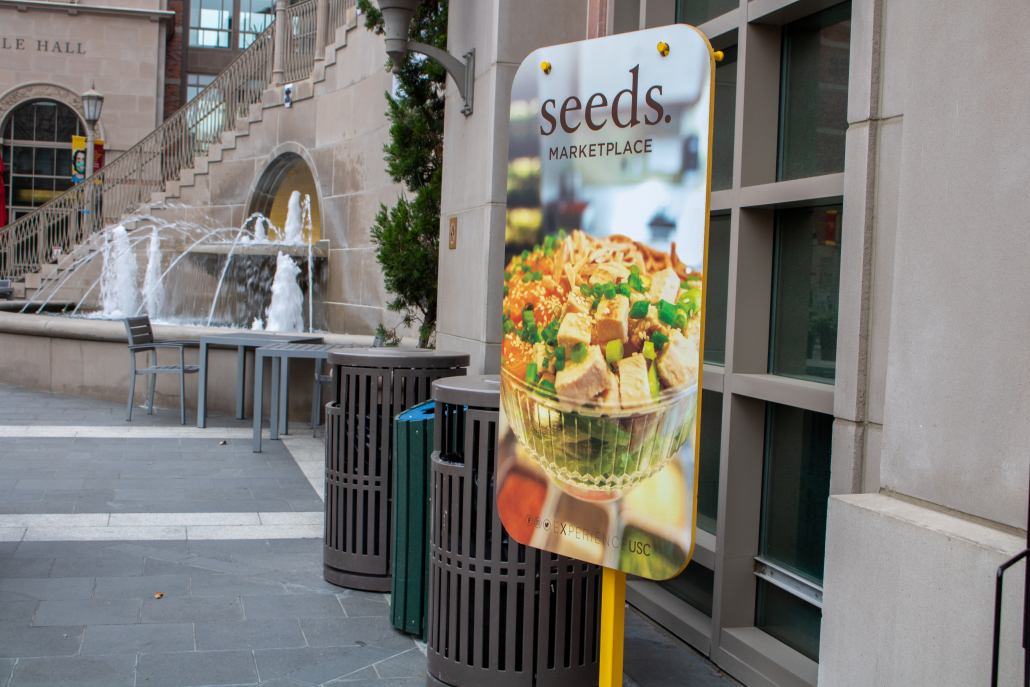Diverse dining options are necessary for student health

Freshman 15: It’s become a universally-accepted maxim that students take as a foreboding of their inevitable college weight gain. Hence, college students often enter school with low expectations of the quality of their food. Students often admit they only ate two meals that day or stocked up at the local Trader Joe’s to compensate for the lack of available healthy food options.
While some consider USC’s meal options sub-par, with others considering them sorely insufficient, USC is bereft of diverse dining options and more specifically, a variety of healthy options.
USC offers three dining halls and a variety of dining spots, including the six at Ronald Tutor Campus Center: Seeds Marketplace, The Kitchen, Burger Crush, Panda Express, Verde and C&G Co. While nine dining options may seem adequate at face value, their restrictive hours often leave students with just a few options at their disposal. For instance, C&G isn’t open on weekends and The Kitchen is indefinitely closed.
Students are left at a crossroads because they pay such an exorbitant price for their meal plan but have such few options that comply. For example, Seeds only has nine student meal plan lunch options. Limited dining options lend themselves to unhealthy meal options.
Students with dietary restrictions or health conscious attitudes are left to suffer. Ironically enough, USC hosted a Zoom for faculty and staff — “Healthy Habits Webinar Series” — and one section focused on “Healthy Food and Fitness on Campus.” Some of their suggestions included ordering brown rice sushi or super greens from Seeds, choosing brown rice and mushroom chicken from Panda Express, adding guacamole to your bowl at Verde and customizing an acai bowl from C&G to lower sugar and calorie intake.
While USC offers these Zoom sessions to educate students on healthy alternatives, it’s disappointing that its suggestions require actual payment. The Cardinal meal plan, the cheapest and most rudimentary meal plan, costs $3,315 per semester. Students shouldn’t be forced to pay more money just so they can get daily nutritious meals. By the same token, students confined to the meal plan shouldn’t be forced to have the same bowl from Verde or the same protein smoothie from C&G just because those are the only seemingly healthy options.
Students’ mood, study habits and stamina depend on what they put in their bodies. There have been a number of studies to evaluate whether or not there’s a causal relationship between diet and school performance.
For example, Michelle D. Florence, Mark Asbridge and Paul J. Veugelers, faculty members at Dalhousie University, conducted a study to examine the effects of diet quality on academic performance. They concluded there is an association between diet quality and academic performance among school-aged children, thereby showing the importance for schools to offer healthy food options earlier in a child’s development.
Additionally, a longitudinal study of weight gain in freshman students found there to be some validity to the Freshman 15 phenomenon. Researchers found “that first year university students on average gained 1.36 kg (3lbs) (CI: 1.15–1.57) over a period of 6 weeks to eight months.” They also concluded that 60.9% of freshman students gained weight, with 9.3% of first-year students gaining at least 15 pounds.
As freshmen find their footing and slowly acclimatize to new meal and fitness schedules, weight gain — to some extent — is both predictable and understandable. This can be exacerbated by student’s tendency to stress-eat when overwhelmed with work. While USC could maneuver this by offering courses on healthy eating habits, weight gain on such a large scale is concerning and must be addressed.
The aforementioned studies justify why USC should offer more healthy options to better help students thrive in the academic and social setting. Beyond the general importance of having a healthy palette, college is where students begin developing and honing their daily habits, and these habits often transcend beyond their four years and take root in their adult life. Unsurprisingly, studies show that unhealthy college eating habits are a contributing factor to the obesity epidemic that plagues the United States.
USC has the power to offer more dining options on its meal plans while simultaneously boasting more healthy alternatives, which would allow students to prioritize their health. They say college is the start of the rest of your life, so shouldn’t we be able to start that life on a healthy note?

